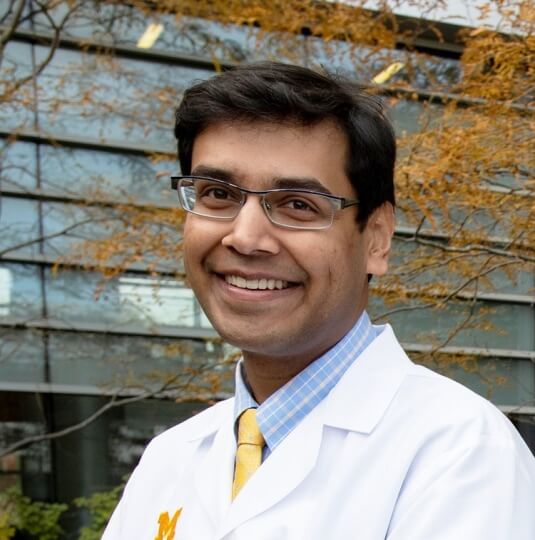Nambi Nallasamy, A.B. '06, M.D. '12
Sometimes a single seminar becomes the catalyst for an entire career. Nambi Nallasamy, A.B. '06, M.D. '12, was a freshman when he registered for a seminar on the neurophysiology of visual perception, taught by Harvard Medical School Professor of Neurobiology and Nobel laureate Dr. David Hubel. The class combined neuroscience and computation in ways Nallasamy had never imagined.
“The seminar solidified the idea that we could understand what individual neurons do in the visual cortex, but beyond that, we could see how the aggregation of inputs from a set of neurons could build higher-level representations of the visual world,” Nallasamy said. “What was truly eye-opening (pun intended) was realizing that these interactions could be modeled mathematically and simulated.”
Mathematics, computer modeling and vision were forever linked for Nallasamy after that, a link that has informed every career choice he’s made over the last 20 years. He dual-concentrated in computer science and mathematics at the Harvard John A. Paulson School of Engineering and Applied Sciences (SEAS), and from there got his medical degree through the Harvard-MIT Health Sciences and Technology program. Nallasamy now holds two appointments at the University of Michigan: as an Assistant Professor of Ophthalmology and Visual Sciences at the Kellogg Eye Center, and as an Assistant Professor of Computational Medicine and Bioinformatics, where his lab is developing ophthalmologic diagnostic tools that use computer vision and machine learning.
“Ophthalmology, and corneal transplantation in particular, gives me the opportunity to restore vision in a pretty dramatic way for patients with certain conditions,” Nallasamy said. “I can see a patient with a cloudy cornea, perform a corneal graft, and the patient can go from not seeing very much to seeing well and actually being able to function and get back to their day-to-day life. It reminds me every day of the impact that vision can have on a person’s life and drives me to build tools to help patients who can’t be healed with current techniques.”
Nallasamy is in his sixth year as an ophthalmologist and surgeon at University of Michigan’s Kellogg Eye Center. He worked as a resident physician in the Duke University Health System and was then a Fellow in Corneal and Refractive Surgery at Bascom Palmer Eye Institute in Miami.
Nallasamy now splits his time between the lab and the operating room, and his research is supported by grants from the National Institutes of Health. His lab develops computer vision and machine learning algorithms to improve surgical outcomes, including AI-powered real-time intraoperative decision support for cataract surgery. The tools his lab has developed can quickly identify patients at risk for adverse outcomes based on how their eyes respond to surgical maneuvers and advise surgeons to alter their surgical approach to preemptively mitigate risk. His lab also uses computer vision and machine learning to improve ophthalmic diagnostics from the front of the eye (diagnosing tumors of the ocular surface) to the back of the eye (using electroretinography to diagnose diseases of the retina).
“I’ve been fortunate that ophthalmology is a very imaging-intensive field, even surgically. While my lab has been able to generate some of the largest ophthalmic datasets in the world and our machines have begun to understand cataract surgery, I’d really like to do this on a larger scale. We’re already expanding to different types of ophthalmic surgery, and other forms of surgery outside of ophthalmology,” Nallasamy said. “The goal is to see the technology we’re developing become an integral piece of the operating room, so that machines can help us perform all forms of surgery more safely and successfully.”
While at Harvard, Nallasamy co-founded a number of small ventures, including one that predicted possible differential diagnoses of ophthalmic diseases based on symptoms and exam findings. Machine learning research was still in its early stages back then, but Nallasamy began to immerse himself in it through courses taught by Leslie Valiant, T. Jefferson Coolidge Professor of Computer Science and Applied Mathematics. Nallasamy may have left SEAS almost 20 years ago, but the work he did back then is still the foundation of his research today.
“The underpinnings were all there when I was at Harvard,” he said. “It made sense that the world would eventually see the potential of computer vision and machine learning, and I’m thrilled to play a part in making these technologies work for our patients.”
Press Contact
Matt Goisman | mgoisman@g.harvard.edu
